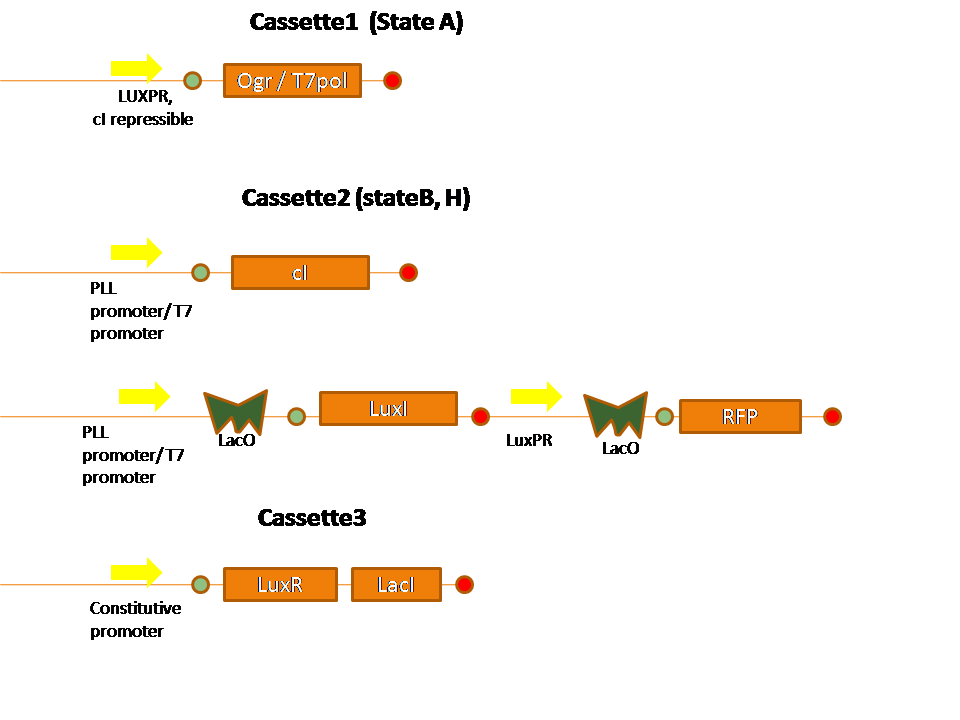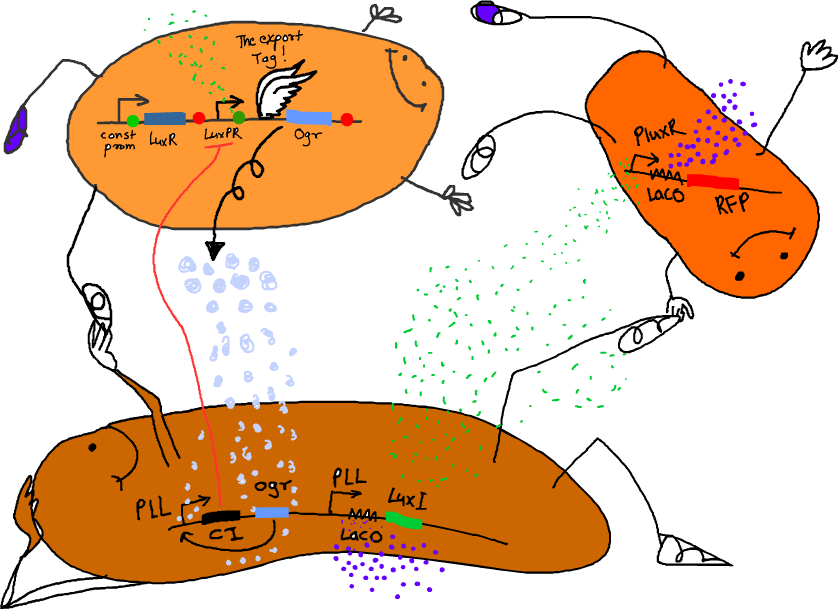Team:IBB Pune/protein-based-signalling
From 2009.igem.org
Samitwatve (Talk | contribs) (→Problems Associated with such an Approach) |
Samitwatve (Talk | contribs) |
||
| Line 1: | Line 1: | ||
| + | {{Team:IBB_Pune/header}} | ||
| + | {{Team:IBB_Pune/menu}} | ||
=The Complete Turing Machine= | =The Complete Turing Machine= | ||
Revision as of 01:00, 22 October 2009

- Home
- Team
- Project
Summary Details Results Modeling
- Related
- Safety
- Parts
- Notebook
Contents
The Complete Turing Machine
The above image is a representation of the complete turing machine including inter state regulation. This model is true to Alan Turing's vision of multi-mutually exclusive states and the states being regulated by one another through outputs.
Working of the Construct
In the above construct, there are three independent modules that function
- A constitutively working module which produces LuxR protein and LacI and Cassette 1 (encodes ogr and activates state 'B')
- A State-'B' which is activated by State' A' and which in turn represses the working of the default state
- An AND gate regulated activation of the turing machine function (it could be lysis, expression of a fluorescent protein or the synthesis of vanillin or methyl salicylate)
The default state of the turing machine is 'A'. In this state it encounters a '0' (represented by Lactose) first.However there are no Lactose responsive elements in either the first or the second module. The third Module which has such a module however also requires the presence of the phage protein 'ogr ' . Hence the first 0 is unable to produce any effect and the machine moves on to the next cell in the tape while remaining in state A.
The machine now encounters a 1 in this default state 'A' (represented by AHL). This results in the activation of the second module which in turn produces more of ogr. This acts like a positive feedback loop and hence state 'B' is switched on and can remain active without intervention from cassette 1.
Cassette 2 also encodes for the phage lambda cI repressor protein which represses cassette 1. Thus we have a system in which the two states are mutually exclusive. In state 'B', when the machine encounters a '1', it keeps the '1' unchanged and transits to the next cell.
Now in this state, when the machine encounters a '0' the AND gate obtains both its inputs viz. ogr and lactose which results in the production of Homoserine Lactone Synthase (enzyme producing AHL). This results in the conversion of the '0' to a '1'. Therefore this construct behaves like a unary adder as per Turing's specification.
Problems Associated with such an Approach
- At 6.5kb the construct too darn BIG!
- It is a metabolic load on the cell.
- Assembling these many parts together is extremely challenging by using even the most advanced molecular biology techniques.
- Transformation of such a large construct is difficult.
- It poses major complications with respect to quality control, sequencing and data validation.
One of the methods of solving these problems is to simplify the construct.
Modular Systems
We decided to use a modular approach to tackle the problems enlisted above.
We therefore decided to divide the complicated construct into three separate interdependent strains which together combine to form the Unary Adder.
In this system the first module gets activated in the presence of AHL ( '1' ) and produces ogr attached to an export tag (YcdB or TorA) this results in the export of ogr protein which acts as an input for the second module.
The second module gets activated by ogr and produces phage lambda repressor cI protein and more ogr protein in response. The cI protein serves to turn the first module 'off' and and keeps itself on by a positive feedback loop regulated by ogr.
The third module gets activated in response to extracellular lactose and ogr and produces RFP. This indicates the conversion of a '0' to '1'.
This functions as a unary adder 9
Proof-of-concept
As a proof of concept of the export-based signalling machinery, we attempted to test the working of the export tags by fusing them upstream of Green Fluorescent Protein.
Retrieved from "http://2009.igem.org/Team:IBB_Pune/protein-based-signalling"
 "
"


